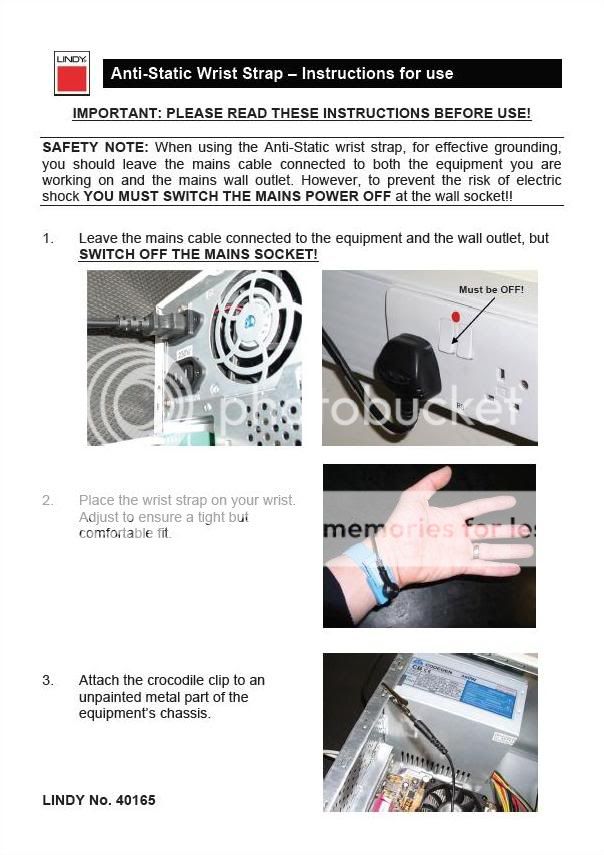Hi all,
I'm building a computer (my first build) that uses some very expensive (to me) components and am concerned about damaging said components with static discharges.
I live in an extremely dry climate and the ONLY place I can build this computer is in a carpeted room. LOTS of static electricity is generated by even the slightest movements in my house. My wife and I are constantly shocking each other and everything else around here. It sort of sux. I considered going barefoot while building the computer, but it's damned cold in this house.....
Anyway, I was in Scotland a few months back and bought this nice anti-static wrist strap:
Lindy Anti-Static Wrist Strap
Here are the instructions that came with this wrist strap:

As you can see, the manufacturer directs that I attach the grounding strap lead to the computer case, which they direct shall, in turn, via the PSU, be connected to the ground receptacle in the wall socket. However, this won't work for me, since I've not yet installed my PSU into my computer case (I think it is going to be easier to install the mobo with the PSU uninstalled).
I searched around a few places and discovered that many authoritative sources recommend that an anti-static wrist strap's grounding lead be connected, either directly or indirectly, to the ground receptacle in a wall socket.
For instance, PCWorld recommends that the wrist strap be grounded to the wall socket's ground receptacle:
http://www.pcworld.com/article/82184/avoid_static_damage_to_your_pc.html
CompTIA's A+ (Aplus) Certification exams consider the wrist strap being grounded (indirectly) to the wall socket's ground receptacle as the correct choice, if you want to get the correct answer on said exams:
http://www.pccomputernotes.com/esd/esd2.htm
In addition, eHow recommends that same thing (indirect connection):
http://www.ehow.com/how_7566000_use-antistatic-wristbands-mats.html
as does http://www.build-your-own-cheap-computer.com/static-electricity.html
I could go on and on, but that's not the point of this post. Since I am personally more comfortable with being grounded to the Earth, I'm considering connecting the grounding lead of my wrist strap directly to the ground receptacle in my wall outlet. During my research, I found some sources that suggest that I just need to be at the same potential as my computer case (which, according to said sources, can be "standalone" with respect to any other electrical conductors), but the very specific manufacturer instructions for my wrist strap suggest otherwise.
I live in the U.S. and my house's electrical system is grounded in accordance with the 1995 US Electrical Code. Being the skeptic, I tested the wall socket I'd be using with this little Ground Tester I had out in the garage, and all was copasetic.
Does anyone think I'll fry my new computer if I connect the ground lead of my wrist strap directly to the ground receptacle in my wall outlet?
TIA!
I'm building a computer (my first build) that uses some very expensive (to me) components and am concerned about damaging said components with static discharges.
I live in an extremely dry climate and the ONLY place I can build this computer is in a carpeted room. LOTS of static electricity is generated by even the slightest movements in my house. My wife and I are constantly shocking each other and everything else around here. It sort of sux. I considered going barefoot while building the computer, but it's damned cold in this house.....
Anyway, I was in Scotland a few months back and bought this nice anti-static wrist strap:
Lindy Anti-Static Wrist Strap
Here are the instructions that came with this wrist strap:

As you can see, the manufacturer directs that I attach the grounding strap lead to the computer case, which they direct shall, in turn, via the PSU, be connected to the ground receptacle in the wall socket. However, this won't work for me, since I've not yet installed my PSU into my computer case (I think it is going to be easier to install the mobo with the PSU uninstalled).
I searched around a few places and discovered that many authoritative sources recommend that an anti-static wrist strap's grounding lead be connected, either directly or indirectly, to the ground receptacle in a wall socket.
For instance, PCWorld recommends that the wrist strap be grounded to the wall socket's ground receptacle:
http://www.pcworld.com/article/82184/avoid_static_damage_to_your_pc.html
CompTIA's A+ (Aplus) Certification exams consider the wrist strap being grounded (indirectly) to the wall socket's ground receptacle as the correct choice, if you want to get the correct answer on said exams:
http://www.pccomputernotes.com/esd/esd2.htm
In addition, eHow recommends that same thing (indirect connection):
http://www.ehow.com/how_7566000_use-antistatic-wristbands-mats.html
as does http://www.build-your-own-cheap-computer.com/static-electricity.html
I could go on and on, but that's not the point of this post. Since I am personally more comfortable with being grounded to the Earth, I'm considering connecting the grounding lead of my wrist strap directly to the ground receptacle in my wall outlet. During my research, I found some sources that suggest that I just need to be at the same potential as my computer case (which, according to said sources, can be "standalone" with respect to any other electrical conductors), but the very specific manufacturer instructions for my wrist strap suggest otherwise.
I live in the U.S. and my house's electrical system is grounded in accordance with the 1995 US Electrical Code. Being the skeptic, I tested the wall socket I'd be using with this little Ground Tester I had out in the garage, and all was copasetic.
Does anyone think I'll fry my new computer if I connect the ground lead of my wrist strap directly to the ground receptacle in my wall outlet?
TIA!



 . As for scottish engineers or the british army in general (Discapline)
. As for scottish engineers or the british army in general (Discapline) 